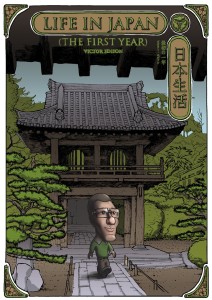JQ Magazine: Book Review – ‘Life in Japan: The First Year’

“Edison’s artistic talent captures Japan’s essence and his autobiographical account is honest and direct. JET Alumni will be able to follow his story and find many of their own experiences and thoughts represented within his work. From his first encounter ordering a hamburger to his dissatisfaction with being a glorified babysitter, his tone and pace keeps the reader hooked.” (Big Ugly Robot Publishing)
By Lana Kitcher (Yamanashi-ken, 2010-12) for JQ magazine. Lana is the business development associate for Bridges to Japan. To read more about Lana’s adventures in Japan and New York, visit her blog at Kitcher’s Café.
Victor Edison is a young man who remembers always having some Japanese influences present throughout his life. His family hosted a Japanese exchange student during his childhood, and he was fascinated by anime and manga from a young age. After graduation he found himself working a job he didn’t really want that wasn’t really going anywhere. A friend that was working in Japan at the time encouraged him to apply to be an English teacher and all he could respond to this was, “why not?”
Published by Nagoya-based Big Ugly Robot Press, Life in Japan: The First Year is a bilingual graphic novel written and drawn by Edison about his first year working for an English language school in Mie Prefecture. With little previous knowledge of the Japanese language or customs, he travels blindly to his new home armed only with his enthusiasm and determination to succeed, his ultimate goal to one day become a full-time artist.
His first choice was to work in Tokyo, simply because that was all he knew. After his interview with “Noba,” he soon learns that he has been offered a position in Mie, and accepts.
He starts work at an English conversation school located in a semi-rural area. While the majority of the clients were adults and young adults, the teachers often had to “teach” toddler classes as well. Because the school was located in a shopping mall, many parents would drop their kids off at the English school to fit in some uninterrupted shopping time. The teachers quickly learned that the child classes were thinly disguised babysitting sessions.
Although he often felt like he was drowning at work and struggling to keep up, when he started settling into a routine and feeling more comfortable he began taking a few trips to other locations around Japan. This gave him a new set of experiences, and new material for his comics. In addition to his traveling, he was able to start setting time aside for his art and language studies. Several of his art projects from his time in Japan can be found within the pages here.
Edison’s artistic talent captures Japan’s essence and his autobiographical account is honest and direct. JET Alumni will be able to follow his story and find many of their own experiences and thoughts represented within his work. From his first encounter ordering a hamburger to his dissatisfaction with being a glorified babysitter, his tone and pace keeps the reader hooked throughout, allowing us to relive those vulnerable and turbulent first few months. He is also able to find humor in these experiences, which enable us to appreciate the moments and make a connection with the author. He is also able to write honestly and recount vividly, as we see in his visual representation.
Edison’s story is not only a great read for the former expatriate, but also for Japanese citizens that are wondering what it is like to be a foreigner in Japan. Although the Japanese translation can be distracting while reading, it allows insight into the foreign experience, which would otherwise be inaccessible to them.
By reading Life in Japan, it is possible to see that regardless of the program you work for, the age group you teach, or what you look like, many of the challenges that we face as teachers and foreigners in Japan are universal: we arrive with expectations that are quickly shaken, and we face times of uncertainty and growth. Regardless of the exact experience, we all leave Japan changed—usually in a good way—that refuses to allow us to forget the people, places, and encounters. Edison thought that teaching English in Japan would be different. He thought his coworkers would be more serious, or that he would have more free time for his art. If you just returned from Japan last week, or have been back for ten years, you’ll be able to find a chapter of this book that resonates with your own story.
Although he doesn’t mention it in great detail, it can be deduced (or learned through his blog) that Edison is still living in Japan today. He continues to follow his passion doing art, teaching English, and spending time with his family. Perhaps we will get to read about his latest adventures in his next book.
He starts off by trying to answer the question, “so what brought you to Japan?” Although he doesn’t have a concise answer by the end, he knows that it was worth it. This graphic novel is perfect for a friend who will soon be venturing to Japan to become an English teacher or alum looking for a humorous and accurate account of what it’s like to live and teach there.
There is a timeless quality to Japan that you can observe by reading works by different authors across history. Consider comparing Life in Japan to works by Lafcadio Hearn (1850-1904), in addition to my recent review on Laura Kriska’s book The Accidental Office Lady (1998). On the surface it may feel like Japan has transformed, but you will notice deep cultural roots that remain unchanged.
For more JQ magazine book reviews, click here.


Comments are closed.